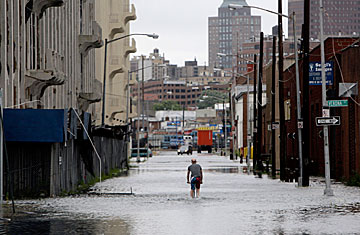
A man pedals through a flooded street in Brooklyn on Sunday, Aug. 28, 2011. Hurricane Irene's heavy rains caused some flooding, but all in all, New York City was spared the worst
(2 of 2)
As they have more and more in recent natural disasters, mayors took to social media to help spread their message and allow people to report when they needed assistance. Cory Booker, the mayor of Newark, N.J., famously used Twitter to help city officials find and dig people out of their homes during January's giant blizzard. Booker was at it again during Irene, tweeting back and forth with residents of Newark, dispatching resources and taking pizzas to famished firemen. "We are up to 10 water rescues of motorists (& one dog) stranded on flooded roads," Booker tweeted just after Irene hit Coney Island. "Please stay inside."
While New York City may have gotten the lion's share of attention from a storm that did far more damage elsewhere, there were serious concerns about the possible level of destruction on a city of buildings stacked on an island and surrounded by water. In the days leading up to the hurricane, there was worry that the cranes at the Ground Zero construction site would be at risk in high winds. Hours after the storm pushed north, snarling winds whipped up and down Church Street, a wide boulevard in lower Manhattan that leads to the World Trade Center site. The winds snapped across the construction zone and up West Broadway before changing direction at the same high speed. But the Ground Zero site appears to have suffered no serious damage. The cranes on the top and side of the Freedom Tower remain in place, and Bloomberg said the construction would continue on schedule. Even the American flags tied to the two large cranes in the middle of Ground Zero made it through the storm. "Well, we tied them down pretty tight," one of the construction workers said. "But yeah, the flags survived the hurricane."
Many New Yorkers may be disappointed in Irene's relatively wimpy wrath, but they face some challenges in the coming days. On Sunday, Bloomberg said the city was now moving to "restore and return" mode. The more than 300,000 people who were evacuated from low-lying areas of the city were allowed to return to their homes. More than 62,000 people in the city were without power on the day after the storm, and the Long Island Power Authority reports that power outages affected more than 460,000 people on Long Island.
But as the city returns to its normal bustling schedule, nothing will be more important than getting public transportation back on line. The Metropolitan Transportation Authority (MTA) moved all subway trains out of the Brooklyn yards where they are stored when not in service, a decision that appears to have paid off, as those yards were flooded, according to MTA chairman Jay Walder. The MTA, along with city and state police, has started the painstaking process of examining the subway tunnels and tracks for damage. MTA crews will literally walk the hundreds of miles of tracks, inspecting and repairing damages, then empty cars will be run over the tracks to ensure they can safely operate. The worst fears, that the tunnels running under rivers between New York City's boroughs would be flooded with salt water did not materialize, but the Metro North commuter rails to Westchester County and southern Connecticut suffered severe flooding, and Walder did not estimate how long it would take to fix. In the meantime, New Yorkers will face what the mayor has admitted will be a "tough commute," one that will likely leave them more frustrated by a storm that has already proved a disappointment.
